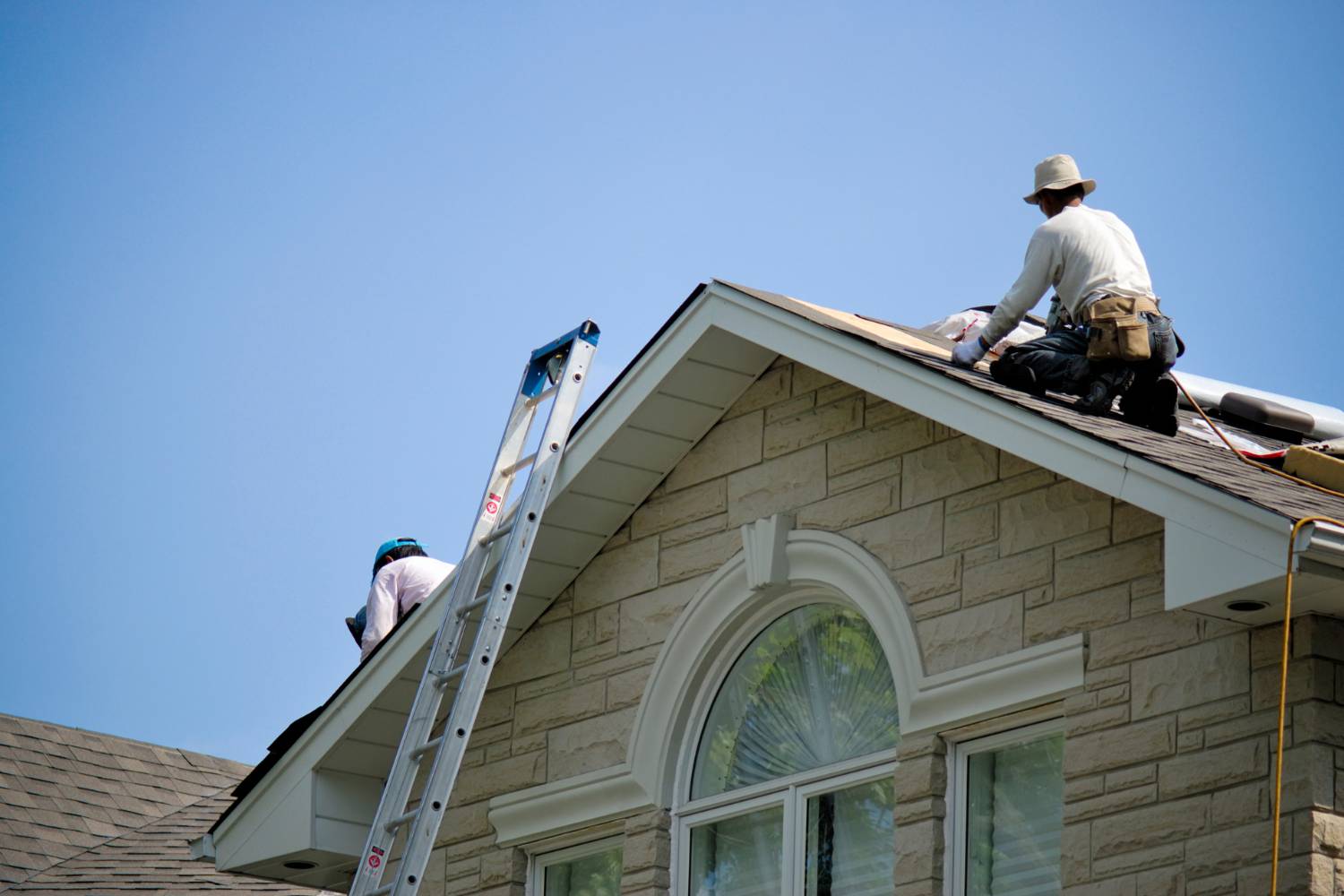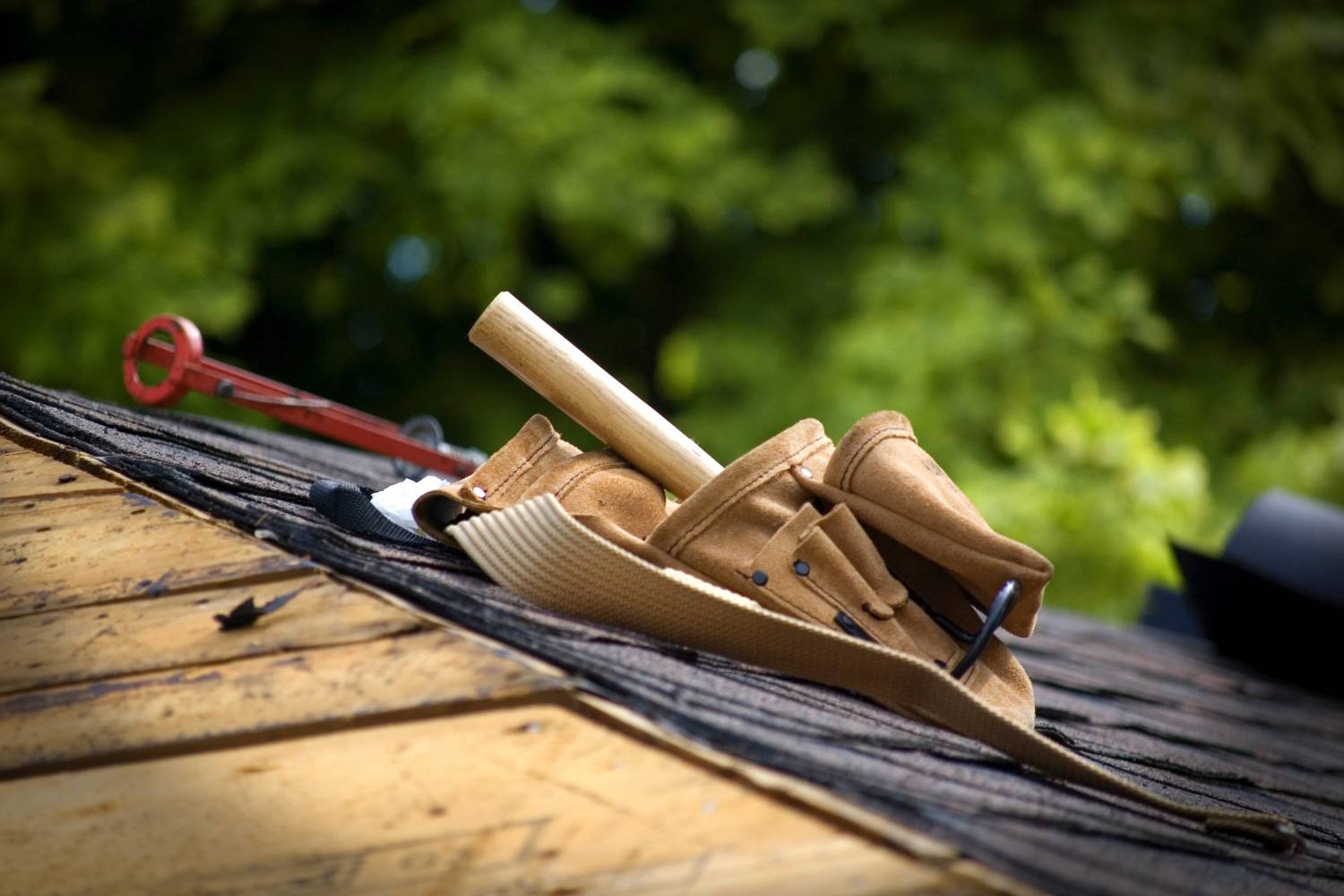Roof leaks are a common headache for homeowners, leading to extensive damage if not promptly addressed. Understanding their causes is essential for effective roof maintenance and avoiding costly repairs.
This article dives into the prevalent causes of roof leaks and offers solutions for prevention and maintenance.
What Are The Common Causes Of Roof Leaks?
Roof leaks are a prevalent issue for homeowners and can lead to significant damage if not addressed promptly. Understanding the common causes of roof leaks can help maintain your roof effectively and prevent costly repairs. Below are detailed explanations of the most common causes of roof leaks:
Damaged Or Missing Shingles
- Weather Damage: Shingles are the first line of defence against the elements. Strong winds, hail, and heavy rains can cause shingles to crack, curl, or become dislodged. When shingles are missing or damaged, the underlying layers of the roof become exposed to water infiltration.
- Ageing: Over time, shingles can deteriorate due to prolonged exposure to UV rays and varying weather conditions. This aging process can make shingles brittle and less effective at keeping water out.
Cracked Flashing
- Function of Flashing: Flashing is used to seal and protect joints in the roof, particularly around roof structures like chimneys, vents, and skylights. It is typically made of thin metal and is crucial for preventing water seepage.
- Common Issues: Flashing can crack or corrode due to temperature fluctuations, weather exposure, or poor installation. When flashing fails, it can allow water to penetrate these vulnerable areas, leading to leaks.
Improperly Sealed Valleys
- Role of Valleys: Roof valleys are the internal angles where two roof slopes meet. They are designed to channel water off the roof efficiently.
- Potential Problems: If the sealing in the valleys is not done correctly or if it deteriorates over time, water can seep through the cracks and into the roof structure, causing leaks.
Ice Dams
- Formation: Ice dams form when heat from the attic causes snow on the roof to melt. The melted water flows down to the colder edges of the roof and refreezes, forming a dam.
- Consequences: This dam blocks additional melting snow from draining properly. The trapped water can then back up under the shingles and leak into the home, causing significant damage to the roof and interior.
Clogged Gutters
- Function of Gutters: Gutters are designed to channel water away from the roof and the foundation of the house.
- Impact of Clogs: When gutters become clogged with leaves, dirt, and debris, they can overflow. The excess water can spill over the edges and seep into the roof, causing leaks and potential structural damage.
Poor Ventilation
- Importance of Ventilation: Proper attic ventilation helps to regulate temperature and moisture levels in the attic space.
- Problems from Poor Ventilation: Without adequate ventilation, moisture can accumulate, leading to mould and rot in the roof’s structural components. This can weaken the roof and create conditions conducive to leaks.
Cracked Chimney
- Chimney Construction: Chimneys are often built from bricks and mortar, which can crack due to weather exposure and temperature changes.
- Leak Points: Cracks in the chimney or its flashing can allow water to enter the roof, causing leaks around the chimney area.
How Can Regular Inspections Help Prevent Leaks?
Regular roof inspections are essential for maintaining the integrity of your home and preventing costly water damage. By identifying potential issues early, you can avoid major problems and extend the lifespan of your roof. Here are some key ways regular inspections can help prevent leaks:
Identify Potential Issues Early
Regular inspections can help detect minor issues, such as small leaks, cracked shingles, or damaged flashing, before they escalate into major problems. Early detection allows for timely repairs, preventing small issues from causing significant damage to your roof and home’s interior.
Extend The Life Of Your Roof
Regular inspections ensure that any wear and tear are promptly addressed. This proactive approach can significantly extend the life of your roof. By keeping your roof in good condition through regular inspections, you can avoid the need for premature and costly roof replacements.
Ensure Safety
A damaged roof can compromise the structural integrity of your home, posing safety risks to your family. Regular inspections can identify and rectify these risks. Additionally, leaks can lead to mould growth, which can cause health issues. Regular inspections help prevent such hazards by ensuring that leaks are promptly fixed.
Check Critical Roof Components
Inspecting the attic for moisture and mould can reveal hidden leaks and help maintain the health of your roof. Regularly checking the flashing and seals around roof penetrations like chimneys, vents, and skylights ensures they are intact and watertight.
Gutter Maintenance
Regularly cleaning gutters prevents debris buildup, which can lead to water overflow and leaks. Well-maintained gutters direct water away from the roof and foundation, preventing leaks and structural damage.
Remove Roof Debris
Removing leaves, branches, and other debris from roof valleys prevents water accumulation and leaks. Keeping the roof clear of debris ensures that water flows freely off the roof, reducing the risk of leaks.
Trim Overhanging Trees
Trimming trees away from the roof prevents damage from falling branches and reduces leaf accumulation in gutters. Ensuring that tree branches do not shade the roof excessively helps prevent algae growth, which can deteriorate roofing materials.
Protect Against Animal Damage
Regular inspections can identify and remove animal nests that trap water and cause leaks. Ensuring that there are no gaps or entry points for animals helps protect your roof from damage caused by burrowing critters.
Monitor Shingle Condition
Regularly checking for and replacing missing or damaged shingles prevents water from penetrating the roof. Inspections can reveal damage from hail or high winds, allowing for prompt repairs.
Check For Manufacturer Recalls
Regular inspections by a professional can help identify if your roofing materials are part of a manufacturer recall, allowing for free replacements.
Why Is Cleaning Your Roof Important For Preventing Water Damage?
Maintaining a clean roof is crucial for the overall health of your home. Regular roof cleaning helps in preventing leaks and water damage, which can lead to costly repairs and potential structural issues. Here are several reasons why cleaning your roof is essential for preventing water damage:
Removal Of Debris
Over time, roofs can accumulate debris such as leaves, twigs, and dirt. This debris can clog gutters and downspouts, preventing proper water drainage and leading to water buildup on the roof. A clean roof ensures that water can flow freely, reducing the risk of leaks and water damage. When gutters are clogged, water overflows and seeps into the roof structure, causing leaks and potential damage to the interior of your home.
Prevention Of Moss And Algae Growth
Moss and algae thrive in damp and shaded areas of the roof. These organisms can retain moisture, leading to the deterioration of roofing materials and potential leaks. Regular roof cleaning removes moss and algae, preventing their growth and minimising the risk of water damage. Moss and algae can cause shingles to lift or become loose, creating gaps that allow water to penetrate the roof.
Identification Of Damaged Areas
During the roof cleaning process, professionals can identify damaged or deteriorating areas of the roof. Timely detection of issues such as cracked shingles, damaged flashing, or worn-out seals allows for prompt repairs, preventing water from seeping into the interior of the home. Regular inspections during cleaning help in spotting potential problems before they escalate into major issues, saving you from expensive repairs.
Enhanced Roof Longevity
One of the primary benefits of roof cleaning is the extended lifespan it provides for your roof. Regular cleaning helps remove dirt, leaves, and other debris that can trap moisture and promote the growth of moss, algae, or mould. These organisms can degrade roofing materials, leading to premature deterioration and the need for costly repairs or replacements. By eliminating these harmful elements, you can significantly prolong the lifespan of your roof.
Improved Energy Efficiency
A clean roof is more energy-efficient. When debris, moss, or algae cover the roof's surface, it can impede the reflective properties of the roofing materials. This causes the roof to absorb more heat, increasing energy consumption for cooling. By keeping your roof clean, you can maintain its reflective properties, reducing the heat absorbed and lowering your energy bills.
Early Detection Of Issues
During the roof cleaning, professionals inspect the roof for any signs of damage or potential problems. This allows for early detection of issues such as loose or damaged shingles, cracks, or deteriorated flashing. Identifying these issues promptly can prevent further damage and save you from costly repairs. Early detection of minor problems ensures they are addressed before they cause significant water damage.
Preservation Of Warranty
Many roofing manufacturers require regular maintenance, including roof cleaning, to keep the warranty valid. Failing to comply with these maintenance requirements may void your warranty, leaving you responsible for any repairs or replacements. Regularly cleaning your roof ensures that you meet the warranty conditions, protecting your investment and minimising potential financial risks.
How Can You Improve Roof Ventilation And Insulation To Prevent Leaks?
Proper roof ventilation and insulation are critical to maintaining a healthy and durable roof. They play a significant role in preventing leaks, prolonging the life of your roofing materials, and ensuring the overall efficiency of your home. Here are key strategies to improve roof ventilation and insulation to prevent leaks:
Understand The Role Of Roof Ventilation
Roof ventilation is essential for managing temperature and moisture levels in the attic. Proper ventilation involves the use of intake vents (usually located in the soffits) and exhaust vents (located near the roof's peak). This system allows cool air to enter the attic while warm, moist air is expelled, preventing the buildup of heat and moisture that can lead to condensation, mould growth, and structural damage.
Identify And Install The Right Ventilation System
A well-designed ventilation system typically includes soffit vents for intake and ridge vents for exhaust. This setup ensures a continuous flow of air, maintaining a balanced and controlled environment in the attic. Proper ventilation helps prevent issues like mould, mildew, and ice dams by keeping the attic temperature consistent and dry.
- Soffit Vents: Located under the eaves, these vents allow cool air to enter the attic.
- Ridge Vents: Installed at the roof's peak, these vents allow warm, moist air to escape.
- Gable Vents: Placed in the gable ends of the attic, these vents can supplement soffit and ridge vents.
- Turbine Vents: Use wind power to enhance ventilation but require proper placement to be effective.
Ensure Proper Installation And Maintenance Of Ventilation Components
For roof ventilation to be effective, both intake and exhaust vents must be free from obstructions. Ensure that insulation does not block the soffit vents and that there are no blockages in the ridge vents. Regular maintenance and inspection can help identify and resolve issues before they lead to significant damage.
Enhance Insulation In The Attic
Proper insulation works hand-in-hand with ventilation to maintain a stable attic environment. Insulation helps keep the home warm in winter and cool in summer, reducing the strain on the HVAC system and preventing moisture buildup that can lead to leaks.
- Attic Insulation: Install sufficient insulation in the attic floor to prevent heat transfer between the living space and the attic. Use materials like fibreglass, cellulose, or spray foam for effective thermal resistance.
- Air Sealing: Seal gaps and cracks in the attic to prevent warm, moist air from the living spaces from entering the attic, which can cause condensation and promote mould growth.
Prevent Ice Dams
Ice dams occur when warm air from the attic melts snow on the roof, which then refreezes at the eaves, causing water to back up and leak into the home. Proper ventilation helps maintain an even roof temperature, preventing the formation of ice dams. Additionally, ensure that the attic is well-insulated to keep the warm air inside the living spaces.
Regular Inspections And Maintenance
Regular roof inspections can help identify signs of poor ventilation and insulation, such as mould growth, water stains, and temperature inconsistencies. Addressing these issues promptly can prevent leaks and prolong the life of the roof. Professional roof inspections can also provide a detailed assessment and recommendations for improving ventilation and insulation.
How Can Eco-Friendly Roofing Materials Help Prevent Leaks?
Eco-friendly roofing materials are becoming increasingly popular due to their environmental benefits and their effectiveness in preventing leaks. These sustainable materials not only reduce your carbon footprint but also enhance the durability and efficiency of your roof. Here are some key ways eco-friendly roofing materials can help prevent leaks:
Improved Durability
Eco-friendly roofing materials such as metal roofs, clay tiles, and recycled shingles are designed to withstand harsh weather conditions, including heavy rain, strong winds, and hail. Their durability reduces the likelihood of damage that can lead to leaks. For instance, metal roofs are highly resistant to weathering and have a lifespan of up to 50 years, which significantly reduces the frequency of repairs and replacements.
Enhanced Water Resistance
Many eco-friendly roofing materials are naturally water-resistant or are treated to enhance their water resistance. For example, clay tiles and concrete shingles do not absorb water, reducing the risk of water infiltration. Additionally, recycled rubber shingles are often coated with waterproof materials, providing an extra layer of protection against leaks.
Effective Insulation
Proper insulation is crucial in preventing leaks, as it helps maintain a consistent roof temperature and reduces condensation. Eco-friendly materials such as green roofs (living roofs) provide excellent insulation by using layers of vegetation and soil. This natural insulation helps regulate the roof’s temperature, preventing ice dams in winter and reducing the likelihood of condensation-related leaks.
Promotion Of Proper Drainage
Eco-friendly roofing systems, like green roofs, are designed to promote proper water drainage. These roofs absorb rainwater, reducing runoff and preventing water from pooling on the roof. Proper drainage is essential in preventing leaks, as standing water can seep into the roofing materials and cause significant damage over time.
Use Of Recycled And Sustainable Materials
Sustainable roofing materials often incorporate recycled components, such as recycled rubber or plastic, which are inherently durable and resistant to weathering. Using these materials reduces the environmental impact and ensures a long-lasting, leak-resistant roof. For example, recycled rubber shingles are flexible and less likely to crack under pressure, reducing the risk of leaks.
Lower Maintenance Requirements
Eco-friendly roofing materials typically require less maintenance compared to traditional materials. This reduced maintenance translates to fewer opportunities for leaks to develop. For instance, solar shingles not only generate energy but also provide a robust, low-maintenance roofing solution that is less prone to damage.
Conclusion
Understanding the common causes of roof leaks and taking proactive steps towards prevention is essential for maintaining the integrity and longevity of your roof. Regular inspections, proper cleaning, and timely maintenance can significantly reduce the risk of leaks and water damage. By addressing issues such as damaged shingles, cracked flashing, clogged gutters, and poor ventilation, homeowners can prevent minor problems from escalating into major repairs.
Additionally, investing in eco-friendly roofing materials and enhancing roof ventilation and insulation can further protect your home from leaks while contributing to environmental sustainability. Prioritising these preventative measures not only safeguards your property but also ensures a safe and healthy living environment.
Frequently Asked Questions
Common causes of roof leaks include damaged or missing shingles, cracked flashing, improperly sealed valleys, ice dams, clogged gutters, poor attic ventilation, and cracked chimneys. Weather damage and ageing can also deteriorate roofing materials, making them more susceptible to leaks.
It's recommended to inspect your roof at least twice a year, ideally in the spring and fall. Additionally, after major storms or severe weather, an inspection can help identify and address any potential damage early, preventing small issues from becoming significant problems.
To improve roof ventilation, ensure that your attic has both intake and exhaust vents, such as soffit vents for intake and ridge vents for exhaust. Regularly check for obstructions. Enhancing insulation involves installing sufficient attic insulation and sealing any gaps to prevent warm, moist air from entering the attic and causing condensation.
Regular roof cleaning removes debris that can clog gutters and downspouts, preventing proper water drainage. It also eliminates moss and algae growth, which can retain moisture and deteriorate roofing materials. Cleaning helps identify damaged areas for prompt repair, extending the roof's lifespan and maintaining its energy efficiency.
Yes, eco-friendly roofing materials such as metal roofs, clay tiles, and recycled shingles are highly durable and water-resistant. They often provide better insulation and promote proper drainage, reducing the risk of leaks. These materials are designed to withstand harsh weather conditions and typically require less maintenance, further reducing leak opportunities.


